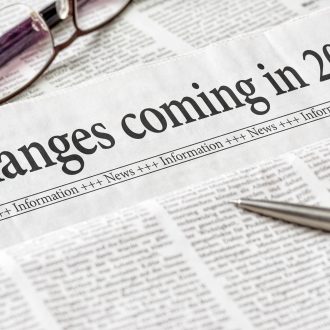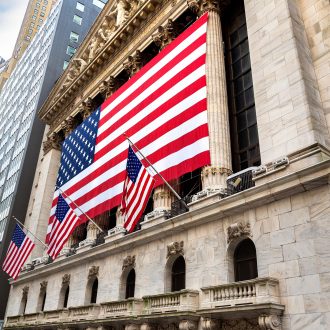
The Flyover:
Drama is abundant these days. An awful lot of it comes from the top, referring to President Trump. Sometimes intentional and purposeful, other times not. Regardless, his style is dramatic by any measure, and those tendencies can make for wild swings in both moods and asset prices. But underneath this rapid-fire haphazard news flow is a set of solid fundamentals supporting the US economy that tend to create a virtuous cycle around the globe.
The best way for investors to avoid falling victim to the headlines and the fear they tend to breed is to hold a steady course with a balanced, diversified portfolio. Disciplined investing has been a proven path to financial comfort, increased income levels, and generational wealth transfer in this nation for a very long time. These facts have always been true and nothing that is happening in the world today is likely to change them.
How To View The Current Economy
These are interesting times, aren’t they? So much is happening in places that we are sure will alter the course of history. Whether it is current economic policy, debates about what democracy truly means, or all-things-AI, it seems like the world is changing in a big way. Maybe it is. But then again, maybe it isn’t.
I’m not being naïve about the importance of any of these things I’ve mentioned, nor will I pretend to know the precise outcome of each and every policy, protest, or push into technological progress. I rely on not just my own 30+ years of experience but also the 150+ years of market data and nearly 250 years of our country’s accumulated history to lead me to the conclusion that there will be both pleasant and unpleasant surprises to come. I’ll also venture to guess that those who take strong stands on either side – extremely frightened and wildly optimistic – are going to be wrong. And should they invest along those extreme views, they are going to need a lot of luck.
The future is uncertain, we all know this. And it’s natural to believe the stakes are always getting higher. Perhaps this is what prompted Yogi Berra to say, “The future ain’t what it used to be”. As he also said, “It’s tough to make predictions, especially about the future”, yet many investors make the mistake of drawing conclusions far too soon and paying the price.
A balanced, diversified allocation is one of the simplest ways to overcome behavioral traps, such as overconfidence, recency bias, or good old-fashioned fear and greed. Rather than wasting unrewarded energy by taking on undue risk in the effort to predict any particular outcome or to time leadership changes of all the various asset classes, investors should remain focused on the elements of investing that have not and will not change – diversification, balance, quality, flexibility, steady exposures to multiple sources of potential return, and careful risk management. For good measure, overall allocations should be reanalyzed at each life stage to align with shifting risk tolerances and income needs.
In other words, these timeless rules trump (couldn’t resist) any ephemeral whims or fears that grab us.
I happen to believe data can help ground and protect us from acting too severely in response to our emotions.
Plenty of data tracks shorter term things like monthly retail sales and jobs numbers. These provide valuable insights into the health and direction of the economy at the margin. But here I’d like to highlight some data that isn’t quite as short term focused and has tended to provide insight into more intermediate or even longer-term signs of health throughout the system.
I’m referring to the balance sheets of American households and businesses, both public and private. While the sales and jobs data have been historically reviewed to consider the probability of an impending recession these balance sheet reports speak more about the severity of a potential recession, should one actually occur.
Thankfully these numbers are in good shape.
According to figures from the Federal Reserve Board, thanks to a decade of steady price appreciation, larger down payments, and a housing market that remained resilient even through periods of volatility, American homeowners have hit a remarkable milestone: equity now accounts for 72% of total home values. That’s one of the highest shares on record, dating back to 1960. This surge in equity reflects not just rising prices but also the financial strength of today’s homeowners. Unlike the mid-2000’s, when highly leveraged buyers and minimal down payments left the market vulnerable, today’s owners are sitting on substantial cushions. The foundation of the housing market is much sturdier than in past cycles – making a broad collapse in prices far less likely. Also meaning the response to a downtick in the broader economy or the stock market isn’t likely to have negative compounding effects throughout the system. The translation is that any recession would be relatively mild and asset price drops of all types would be muted.
To be clear, it isn’t just homeowners that are in good shape. Household net worth data recently reported from the Federal Reserve Board includes households of all types. They reported new record highs in net worth and, very importantly, net savings rates. These clearly indicate that the average American household isn’t burdened with excessive debt and has a margin of safety tucked away. Again, with these figures in comfortable ranges, severe hits to the economy are much less likely.
A look at average business entities in America also paints a sturdy picture. According to Reuters, US corporations hold significant cash reserves. Their economists estimate close to $1.1 trillion in excess cash reserves held by non-financial firms. To be fair, while these figures are solid, businesses are operating in a complex world right now, so I don’t want to point to these figures to encourage investors to become overly optimistic. Instead, I think they should be seen as cushions against shocks rather than trampolines to bounce up from.
Now, I can almost hear you saying “sure, that’s great, but what about the mounting debt crisis at the government level”. A fair point, but thankfully this bomb has a long wick. I’ve made it very clear in these pieces before that our government debt issues need to be addressed, but that I don’t anticipate serious attention to the matter from modern era politicians any time soon. Thankfully there is also a lot of hyperbole around these figures as well as a disproportionate focus on the nominal sums of debt rather than their economic impact.
At present, our government reports itself as having total public debt of roughly $36.5 trillion, which is about 121% of our nation’s annual GDP. Those aren’t pretty numbers; but consider that in 2021 that ratio was above 130%. While we’ve continued to rack up debt since then, the other side of the coin is that our GDP has expanded to pull the ratio lower. Another way to see this is through the “debt servicing” figures, which show us what level of GDP has to be spent to pay the interest on the debts we carry. The Peterson Foundation crunches Department of Treasury data to report that net interest costs amounted to about 3.1% of GDP in 2024 and may be at that same level or creep up to 3.2% for 2025. Again, this isn’t great; but it shows what I mean about there being a long wick on this bomb. Nevertheless, these numbers reveal a problem and require our government to implement options to put the budget on a sustainable path.
Our government has righted its ship in the past so there’s no reason to think it can’t do so again. Regardless, from a purely investor-focused standpoint, fixating on this issue is neither necessary nor profitable as counterintuitive as it may seem.
How To Keep Uncle Sam In His Place
Let me wrap up with a sobering reminder about how our indebted government has crept into your pocket.
As I said above, I think the investment landscape is on solid ground. The debt our government carries isn’t stopping companies from innovating and expanding their earnings. It also isn’t stopping wealth creation or fiscal responsibility at the household level.
However, it is changing some of the rules of the road about taxes, and this shows us most notably in the horrible changes that have been made to the treatment of IRA accounts.
As I’ve written about before, remember that your IRA account now belongs almost as much to the government as it does your family.
There are some exceptions, but in most cases, your beneficiaries will need to deplete these accounts and pay taxes due on them within 10 years of your death.
This means they do not get the benefit of growing these assets for their own retirement based on their age and corresponding timeframe. Instead, they get to pay Uncle Sam a lot of taxes and no longer benefit from continued tax-sheltered growth.
In other words, your IRA has become an IOU to the IRS.
I will be more than happy to explain the details of why this awful rule exists and how it is the clearest proof that both sides of the political aisle recognize the need to collect taxes from the middle class, yet don’t have the courage to say so. I’d much rather spend the time walking through alternatives for how to sidestep this huge pothole.
There are methods to use today’s lower tax rates to our advantage to help create tax-advantaged inheritances for people you care a lot more for than Uncle Sam. This is true if you are in the Required Minimum Distributions (RMDs) phase or not yet there. So to all of you with reasonable sums in your IRA (or any form of ‘qualified’ account), let’s be sure to have this conversation of how to put these assets into the best place for you and your family’s future.
The Takeaways:
- It can be easy for us to let our beliefs or emotions cloud our judgment. We can almost refuse to believe hard data when it challenges our current opinions and feelings. But being pragmatic in this way is helpful.
- A level-headed look at most economic data suggests moderate economic growth ahead.
- History suggests this is a perfectly normal and healthy backdrop for investment gains.
- Staying balanced in all ways is a good thing. Emotionally, financially, and beyond.
- The top of the headlines may be shaky on the horizon, but the foundation appears sturdy.
Disclosure
Securities offered through International Assets Advisory, LLC (“IAA”) – Member FINRA/SIPC. Advisory services offered through International Assets Investment Management, LLC (“IAIM”) or Global Assets Advisory LLC (“GAA”) – SEC Registered Investment Advisor(s). IAA, IAIM, and GAA are affiliated entities.
The information provided is based on carefully selected sources, believed to be reliable, but whose accuracy or completeness cannot be guaranteed. Any opinion herein reflects our judgment at this date and is subject to change without notice. This should not be construed as an offer or solicitation to buy or sell securities. This information is not intended to be legal or tax advice. Please consult a tax, legal, or financial professional with questions.
Investors should consider the investment objective, risks, and charges and expenses before investing. Different types of investments involve varying degrees of risk, and there can be no assurance that any specific investment will be either suitable or profitable for a client or prospective client’s wealth management investment portfolio. Past performance is not an indication of future performance. International Assets Advisory, LLC and its affiliates, employees and/or directors may have positions in these securities, and may as principal or agent, buy from or sell to customers. All securities are subject to price and yield change and subject to availability. Investments in securities and insurance products are: NOT FDIC-INSURED/NOT BANK-GUARANTEED/MAY LOSE VALUE. Stocks, options, and mutual funds are subject to market volatility and may lose value. Mutual funds, Unit Investment Trusts and Variable Annuities are sold by prospectus only. Please read the prospectus carefully for important information about fees and risk considerations. Bonds are subject to changes in interest rates, risks of defaults by issuer, and the loss of purchasing power due to inflation, or the risk that an issuer will be unable to make interest or principal payments. Additionally, bonds and short-term investments entail greater inflation risk than stocks. Any fixed-income security sold or redeemed prior to maturity may be subject to a substantial gain or loss. Investing in securities underlying in currencies other than the U.S. dollar involves certain considerations comprising both risk and opportunity not typically associated with investing in U.S. securities. The security may be affected either favorably or unfavorably by fluctuation in the relative rates of exchange between currencies, by exchange control regulations, or by indigenous economic and political developments.



